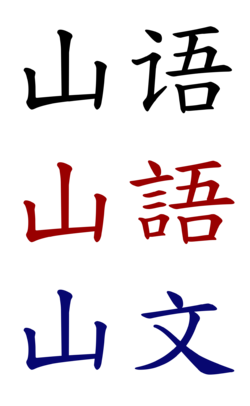Difference between revisions of "Monsilvan language"
m |
|||
| Line 1: | Line 1: | ||
{{Infobox language | {{Infobox language | ||
| name = Monsilvan | | name = Monsilvan | ||
| − | | nativename = {{unbulleted list| | + | | nativename = {{unbulleted list|山文 (Monsilvan)|<small>''Shānwén ([[Pinyin]])</small>}} |
| image = [[File:monsilvan language.png|250px|center]] | | image = [[File:monsilvan language.png|250px|center]] | ||
| states = [[Monsilva]], [[Fujikuni|some areas of Fujikuni]] | | states = [[Monsilva]], [[Fujikuni|some areas of Fujikuni]] | ||
| Line 19: | Line 19: | ||
}} | }} | ||
| − | The '''Monsilvan language''' ( | + | The '''Monsilvan language''' (山文 [[pinyin]]: Shānwén) is one of only two surviving members of the [[Silvitic languages|Silvitic]] [[Languages of Terraconserva|language family]], spoken natively by the ethnic [[Monsilvan people|Monsilvan]] majority and some minority groups living in [[Monsilva]]. About 55 million people speak standard or a dialect of Monsilvan as their first language, and around 10 million people speak Monsilvan as a second, third or higher language. |
The spoken dialects of Monsilvan are sometimes considered by native speakers to be different languages. However, the very obvious mutual intelligibility means they are officialy considered dialects of the original Standard Monsilvan. For example, the most only spoken dialect other than Standard Monsilvan is [[Luhainese]], spoken in the region including and surrounding the state of [[Luhai (state)|Luhai]] in [[Monsilva]]. Outside of Monsilva, it is spoken by many people within Fujikuni, as well as some speakers in Baltanla and in other countries across Terraconserva. Monsilvan is one of the [[Ostlandet Union]]'s many official languages. | The spoken dialects of Monsilvan are sometimes considered by native speakers to be different languages. However, the very obvious mutual intelligibility means they are officialy considered dialects of the original Standard Monsilvan. For example, the most only spoken dialect other than Standard Monsilvan is [[Luhainese]], spoken in the region including and surrounding the state of [[Luhai (state)|Luhai]] in [[Monsilva]]. Outside of Monsilva, it is spoken by many people within Fujikuni, as well as some speakers in Baltanla and in other countries across Terraconserva. Monsilvan is one of the [[Ostlandet Union]]'s many official languages. | ||
Revision as of 12:38, 12 January 2023
| Monsilvan | |
|---|---|
| |
| Native to | Monsilva, some areas of Fujikuni |
| Ethnicity | Monsilvans |
Native speakers | 55 million (first language) 65 million (total) (2022) |
Early form | Shan †
|
| Dialects |
|
| Monsilvan characters (Pinyin) | |
| Official status | |
Official language in | |
| Language codes | |
| ISO 639-1 | Ms |
| ISO 639-2 | Msn |
| ISO 639-3 | Msn |
The Monsilvan language (山文 pinyin: Shānwén) is one of only two surviving members of the Silvitic language family, spoken natively by the ethnic Monsilvan majority and some minority groups living in Monsilva. About 55 million people speak standard or a dialect of Monsilvan as their first language, and around 10 million people speak Monsilvan as a second, third or higher language.
The spoken dialects of Monsilvan are sometimes considered by native speakers to be different languages. However, the very obvious mutual intelligibility means they are officialy considered dialects of the original Standard Monsilvan. For example, the most only spoken dialect other than Standard Monsilvan is Luhainese, spoken in the region including and surrounding the state of Luhai in Monsilva. Outside of Monsilva, it is spoken by many people within Fujikuni, as well as some speakers in Baltanla and in other countries across Terraconserva. Monsilvan is one of the Ostlandet Union's many official languages.
The earliest Monsilvan written records are pre-Xia dynasty Oracle bone script oracle bone inscriptions, which can be dated to 1250 BCE. The phonetic categories of Shan can be reconstructed from the rhymes of ancient poetry. Soon after the Unification of the Monsilvan Kingdoms, Shan went through several sound changes and evolved gradually overtime. After the establishment of the Kingdom of Great Shan, Monsilvan literature and writing became hugely more popular and lead to the wipe out of many lesser-known languages still spoken in the kingdom. By the early 19th century, almost all other members of the Silvitic language family had become extinct and Standard Monsilvan (and its dialects) had become widely known.
Monsilvan uses two scripts which are very similar to each other. The first script is known as "Traditional Shan script", and is the original and most commonly used script. The second script very similar but features some simplifications making certain characters look slightly less complicated. This script is called "Simplified Shan script" is commonly found in handwritten work as it is much quicker and easier to write in than Traditional. An example of Simplified Shan script being used outside of handwritten work is on the Reformed National Party and Liberal Party of Monsilva logos.
Standard Monsilvan is based off the original dialect that was spoken in the current capital of Monsilva, Amking. It was officially established in 1912 as the official language/dialect of the Kingdom of Monsilva and has remained that way ever since. There are still other dialects of Monsilvan that are treated as 'national languages', which was a system set up by former prime minister, Suen Shi-huang, in 1998. National languages are dialects that are aknowledged and protected by the Monsilvan government, but are not used officially in any government context. The most spoken of these 'national languages' is Luhainese, which is spoken by approximately 10 million people as of 2020.
